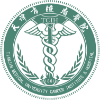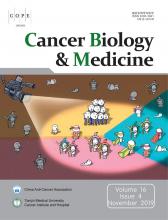Research ArticleOriginal Article
Omics-based integrated analysis identified ATRX as a biomarker associated with glioma diagnosis and prognosis
Yingbin Xie, Yanli Tan, Chao Yang, Xuehao Zhang, Can Xu, Xiaoxia Qiao, Jianglong Xu, Shaohui Tian, Chuan Fang and Chunsheng Kang
Cancer Biology & Medicine November 2019, 16 (4) 784-796; DOI: https://doi.org/10.20892/j.issn.2095-3941.2019.0143
Yingbin Xie
1Department of Neurosurgery, Affiliated Hospital of Hebei University, Baoding 071000, China
2Department of Neurosurgery, Hebei University Medical College, Baoding 071000, China
Yanli Tan
3Department of Pathology, Hebei University Medical College, Baoding 071000, China
4Department of Pathology, Affiliated Hospital of Hebei University, Baoding 071000, China
Chao Yang
5Lab of Neuro-oncology, Tianjin Neurological Institute, Key Laboratory of Post-Neuroinjury Neuro-repair and Regeneration in Central Nervous System, Tianjin Medical University General Hospital, Tianjin 300052, China
Xuehao Zhang
2Department of Neurosurgery, Hebei University Medical College, Baoding 071000, China
Can Xu
2Department of Neurosurgery, Hebei University Medical College, Baoding 071000, China
Xiaoxia Qiao
1Department of Neurosurgery, Affiliated Hospital of Hebei University, Baoding 071000, China
Jianglong Xu
1Department of Neurosurgery, Affiliated Hospital of Hebei University, Baoding 071000, China
Shaohui Tian
1Department of Neurosurgery, Affiliated Hospital of Hebei University, Baoding 071000, China
Chuan Fang
1Department of Neurosurgery, Affiliated Hospital of Hebei University, Baoding 071000, China
Chunsheng Kang
5Lab of Neuro-oncology, Tianjin Neurological Institute, Key Laboratory of Post-Neuroinjury Neuro-repair and Regeneration in Central Nervous System, Tianjin Medical University General Hospital, Tianjin 300052, China
6Department of Oncology, Affiliated Cancer Hospital & Institute of Guangzhou Medical University, Guangzhou 510095, China

References
- 1.↵
- 2.↵
- Castro-Gamero AM,
- Pezuk JA,
- Brassesco MS,
- Tone LG.
- 3.↵
- Han L,
- Liu CY,
- Qi HZ,
- Zhou JH,
- Wen J,
- Wu D, et al.
- 4.↵
- Cai HQ,
- Wang PF,
- Zhang HP,
- Cheng ZJ,
- Li SW,
- He J, et al.
- 5.↵
- Synhaeve NE,
- Van Den Bent MJ,
- French PJ,
- Dinjens WNM,
- Atmodimedjo PN,
- Kros JM, et al.
- 6.↵
- Godek KM,
- Venere M,
- Wu Q,
- Mills KD,
- Hickey WF,
- Rich JN, et al.
- 7.↵
- Stanislaw C,
- Xue Y,
- Wilcox WR.
- 8.↵
- Nandakumar P,
- Mansouri A,
- Das S.
- 9.↵
- 10.
- Van Den Bent MJ,
- Weller M,
- Wen PY,
- Kros JM,
- Aldape K,
- Chang SS.
- 11.↵
- Núñez FJ,
- Mendez FM,
- Kadiyala P,
- Alghamri MS,
- Savelieff MG,
- Garcia-Fabiani MB, et al.
- 12.↵
- Danussi C,
- Bose P,
- Parthasarathy PT,
- Silberman PC,
- Van Arnam JS,
- Vitucci M, et al.
- 13.↵
- Nguyen DT,
- Voon HPJ,
- Xella B,
- Scott C,
- Clynes D,
- Babbs C, et al.
- 14.↵
- Mukherjee J,
- Johannessen TC,
- Ohba S,
- Chow TT,
- Jones L,
- Pandita A, et al.
- 15.↵
- Koschmann C,
- Lowenstein PR,
- Castro MG.
- 16.↵
- Haase S,
- Garcia-Fabiani MB,
- Carney S,
- Altshuler D,
- Núñez FJ,
- Méndez FM, et al.
- 17.↵
- Cai JQ,
- Zhang CB,
- Zhang W,
- Wang GZ,
- Yao K,
- Wang ZL, et al.
- 18.↵
- Modrek AS,
- Golub D,
- Khan T,
- Bready D,
- Prado J,
- Bowman C, et al.
- 19.↵
- Reinhardt A,
- Stichel D,
- Schrimpf D,
- Sahm F,
- Korshunov A,
- Reuss DE, et al.
- 20.
- 21.
- Patil V,
- Mahalingam K.
- 22.↵
- 23.↵
- Liu JY,
- Zhang XB,
- Yan XL,
- Sun M,
- Fan YS,
- Huang Y.
- 24.↵
- Cerami E,
- Gao JJ,
- Dogrusoz U,
- Gross BE,
- Sumer SO,
- Aksoy BA, et al.
- 25.↵
- Gao JJ,
- Aksoy BA,
- Dogrusoz U,
- Dresdner G,
- Gross B,
- Sumer SO, et al.
- 26.↵
- Nguyen DN,
- Heaphy CM,
- De Wilde RF,
- Orr BA,
- Odia Y,
- Eberhart CG, et al.
- 27.↵
- Chaurasia A,
- Park SH,
- Seo JW,
- Park CK.
- 28.↵
- Louis DN,
- Perry A,
- Burger P,
- Ellison DW,
- Reifenberger G,
- Von Deimling A, et al.
- 29.↵
- 30.↵
- Zhou LN,
- Wang ZC,
- Hu CX,
- Zhang CQ,
- Kovatcheva-Datchary P,
- Yu D, et al.
- 31.↵
- Ebrahimi A,
- Skardelly M,
- Bonzheim I,
- Ott I,
- Muhleisen H,
- Eckert F, et al.
- 32.↵
- Deng L,
- Xiong PJ,
- Luo YH,
- Bu X,
- Qian SK,
- Zhong WZ, et al.
- 33.↵
- Liu XY,
- Gerges N,
- Korshunov A,
- Sabha N,
- Khuong-Quang DA,
- Fontebasso AM, et al.
- 34.↵
- 35.↵
- 36.↵
- 37.↵
- Johnson BE,
- Mazor T,
- Hong CB,
- Barnes M,
- Aihara K,
- McLean CY, et al.
- 38.↵
- 39.↵
- Cho SY,
- Park C,
- Na D,
- Han JY,
- Lee J,
- Park OK, et al.
- 40.↵
- 41.↵
- Brennan CW,
- Verhaak RGW,
- McKenna A,
- Campos B,
- Noushmehr H,
- Salama SR, et al.
- 42.↵
- Bettegowda C,
- Agrawal N,
- Jiao YC,
- Sausen M,
- Wood LD,
- Hruban RH, et al.
- 43.↵
- 44.↵
- McNulty SN,
- Cottrell CE,
- Vigh-Conrad KA,
- Carter JH,
- Heusel JW,
- Ansstas G, et al.
- 45.↵
- Han B,
- Cai JQ,
- Gao WD,
- Meng XQ,
- Gao F,
- Wu PF, et al.
- 46.↵
- Valle-García D,
- Qadeer ZA,
- McHugh DS,
- Ghiraldini FG,
- Chowdhury AH,
- Hasson D, et al.
- 47.↵
- Ratnakumar K,
- Duarte LF,
- LeRoy G,
- Hasson D,
- Smeets D,
- Vardabasso C, et al.
- 48.
- Law MJ,
- Lower KM,
- Voon HPJ,
- Hughes JR,
- Garrick D,
- Viprakasit V, et al.
- 49.↵
- Mitson M,
- Kelley LA,
- Sternberg MJE,
- Higgs DR,
- Gibbons RJ.
- 50.↵
- Zhang J,
- Chen XB.
- 51.↵
- Zhang YH,
- Qian YJ,
- Zhang J,
- Yan WS,
- Jung YS,
- Chen MY, et al.
- 52.↵
- Wang HY,
- Tang K,
- Liang TY,
- Zhang WZ,
- Li JY,
- Wang W, et al.
- 53.↵
- Inoue M,
- Nakashima R,
- Enomoto M,
- Koike Y,
- Zhao X,
- Yip K, et al.
In this issue
Omics-based integrated analysis identified ATRX as a biomarker associated with glioma diagnosis and prognosis
Yingbin Xie, Yanli Tan, Chao Yang, Xuehao Zhang, Can Xu, Xiaoxia Qiao, Jianglong Xu, Shaohui Tian, Chuan Fang, Chunsheng Kang
Cancer Biology & Medicine Nov 2019, 16 (4) 784-796; DOI: 10.20892/j.issn.2095-3941.2019.0143
Omics-based integrated analysis identified ATRX as a biomarker associated with glioma diagnosis and prognosis
Yingbin Xie, Yanli Tan, Chao Yang, Xuehao Zhang, Can Xu, Xiaoxia Qiao, Jianglong Xu, Shaohui Tian, Chuan Fang, Chunsheng Kang
Cancer Biology & Medicine Nov 2019, 16 (4) 784-796; DOI: 10.20892/j.issn.2095-3941.2019.0143
Jump to section
Related Articles
- No related articles found.










